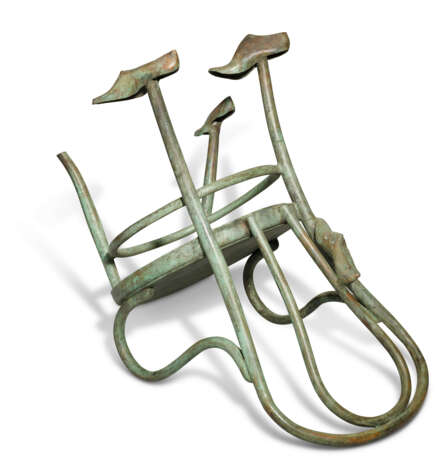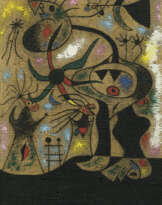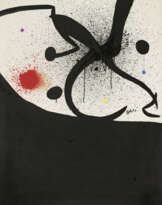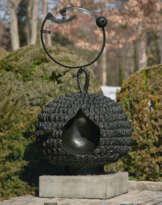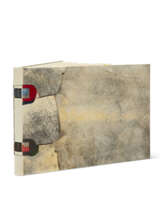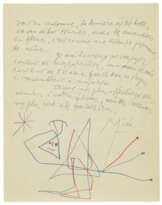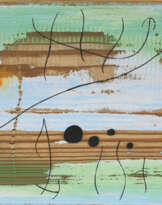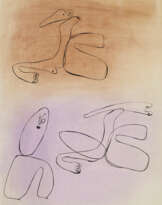ID 929393
Lot 3 | Joan Miró (1893-1983)
Estimate value
€ 250 000 – 350 000
Femmes et oiseaux
signé 'Miró' (en dessous de l'assise); numéroté et avec la marque du fondeur 'CLEMENTI Fondeur Paris N1' (à l'avant de l'assise)
bronze à patine verte
80 x 99 x 65 cm.
Conçu en 1972; cette épreuve fondue en 1972 dans une édition de 2 exemplaires plus une épreuve nominative
signed 'Miró' (underneath the seat); numbered and with the foundry mark 'CLEMENTI Fondeur Paris N1' (at the front of the seat)
bronze with green patina
31 1/2 x 39 x 25 5/8 in.
Conceived in 1972; this bronze cast in 1972 in an edition of 2 plus one nominative cast
Provenance
Pierre Matisse Gallery, New York.
Vente, Sotheby's, New York, 6 mai 2009, lot 225.
Acquis au cours de cette vente par le propriétaire actuel.
Literature
A. Jouffroy et J. Teixidor, Miró, Sculptures, Paris, 1980, p. 186, no. 252 (une autre épreuve illustrée, pl. 252; daté '1973').
E. F. Miró et P. O. Chapel, Joan Miró, Sculptures, Catalogue raisonné, 1928-1982, Paris, 2006, p. 276, no. 289 (une autre épreuve illustrée en couleurs, p. 277).
Exhibited
Cologne, Museum Ludwig, Miró, Der Bildhauer, avril-juin 1987, p. 217, no. 102.
Special notice
Artist's Resale Right ("droit de Suite").
If the Artist's Resale Right Regulations 2006 apply to this lot, the buyer also agrees to pay us an amount equal to the resale royalty provided for in those Regulations, and we undertake to the buyer to pay such amount to the artist's collection agent.
ƒ: In addition to the regular Buyer’s premium, a commission of 5.5%
inclusive of VAT of the hammer price will be charged to the buyer.
It will be refunded to the Buyer upon proof of export of the lot
outside the European Union within the legal time limit.
(Please refer to section VAT refunds)
This item will be transferred to an offsite warehouse after the sale. Please refer to department for information about storage charges and collection
details.
Post lot text
Joan Miró se tourne vers la sculpture pendant la Seconde Guerre mondiale, années solitaires durant lesquelles il se passionne pour l'artisanat de la Catalogne et de la Majorque rurales, qui devient la source d'une approche inédite et dynamique de la sculpture, enracinée dans le monde des objets. Dans ses carnets de l'époque, Miró entrevoit, déjà, la naissance d'une nouvelle vocation : « Quand je sculpte, commencer par les objets que je récolte, comme je me sers des taches sur le papier et des imperfections sur une toile – faire cela ici, à la campagne, d'une manière qui soit vraiment vivante, en communion avec les éléments naturels... En faire comme un collage d'objets divers... C'est bien la seule chose – cette étincelle magique – qui compte dans l'art » (cité dans M. Rowell, ed., Joan Miró, Selected Writings and Interviews, Boston, 1986, p. 175 et 191).
Lorsque cette œuvre voit le jour au début des années soixante-dix, les sculptures tardives de Miró résonnent avec l'ensemble de l'œuvre de Miró, évoquant à la fois la verve ludique et avant-gardiste des années trente surréalistes, et le nationalisme plus tellurique qui marquera ses travaux après son retour en Espagne. « Peindre, sculpter, graver, c'est peut-être donner forme à un mythe », songe Miró en 1974. « Si j'intègre souvent les objets tels qu'ils sont, avec leurs matériaux bruts, ce n'est pas pour obtenir un effet plastique mais par nécessité... J'ai besoin de marcher sur ma terre, de vivre parmi les miens, parce que tout ce qui est populaire est essentiel à mon art » (cité in ibid., p. 21).
Les « sculptures d'assemblage » tel que les nomme Jacques Dupin, sont composées de toutes sortes d'objets récupérés, vraisemblablement issus de l’atelier de Miró et de la région alentour, où l'artiste avait pour habitude de marcher au hasard des champs et des trouvailles, glanant parfois des objets abandonnés qu'il incorporerait plus tard à ses créations.... Dupin l'accompagna lors de nombre de ces promenades quotidiennes à la recherche de l'inattendu. Il se souvient que les choix de Miró étaient loin d'être arbitraires : « Ramasser une vieille boîte de conserve écrasée était un acte important pour lui, une affaire sérieuse. Il était convaincu que tout ce que son pied pouvait friser au bord d'un sentier avait le potentiel de bouleverser notre monde » (J. Dupin, Miró, Paris, 1993, p. 374). « Quand je pars en vadrouille, je ne cherche pas des choses comme on cherche des champignons », explique Miró. « Il y a une force – clac ! – qui me fait baisser les yeux, une force magnétique » (cité in W. Jeffett, in op.cit., Washington, D.C., 2002, p. 34).
Femmes et oiseaux, comme la plupart des sculptures des années 1960-70, a pour sujet la femme, qu'il évoque avec légèreté, humour et poésie, à travers cette chaise culbutée dont les pieds sont surmontés de chaussures, reprenant l’affirmation de l’artiste que ‘Pour moi, un objet, c’est vivant’ (Miró, cité dans cat. exp. Joan Miró, Sculptures 1928-1982, Fondation Botin, Santander, 2018). La féminité et la dimension sexuée de la présente sculpture sont signifiées par la présence des chaussures qui sont en fait les ‘oiseaux’ (mentionnés dans le titre de l’oeuvre), dont le nom catalan ‘ocell’ désigne également le sexe masculin. C’est cette juxtaposition d’objets ordinaires et aléatoirement assemblés, allant contre toute logique, qui créé ce nouveau langage visuel propre à Miró, à la fois poétique et ludique, et qui expose le répertoire illimité de l’imaginaire de l’artiste catalan. Par ses assemblages inattendus, Miró offre un monde dans lequel des objets ordinaires – telles une chaise et des chaussures – se métamorphosent en êtres vivants, humains et animaux, femmes et oiseaux. Joan Miró expliquait ainsi son processus créatif : « Je suis attiré par une force magnétique vers un objet, sans aucune préméditation, puis un autre objet me fascine, lequel se rattache au premier, produisant dès lors un choc poétique. C’est à l’issue de ce coup de foudre plastique, physique, que la poésie opère et cela ne fonctionnerait pas sans lui… » (Miró, cité dans ibid. 2018).
Miró first found his bearings as a sculptor in the solitary years of the Second World War, embracing the culture of peasant craft in rural Catalunya and Mallorca as a source for a new and vital approach to sculpture rooted in the world of objects. In notebooks from this time, Miró anticipated a new engagement with sculpture, writing: “When sculpting, start from the objects I collect, just as I make use of the stains on paper and imperfections in a canvas–do this here in the country in a way that is really alive, in touch with the elements of nature...do it like a collage of various elements...that is the only thing – this magic spark – that counts in art” (quoted in M. Rowell, ed., Joan Miró, Selected Writings and Interviews, Boston, 1986, p. 175 and 191).
By the early 1970s, when the present work was conceived, his sculptures reflected retrospectively on Miró’s oeuvre, invoking both the playful, risk-taking attitude of the Surrealist 1930s and the telluric nationalism more characteristic of his work upon his return to Spain. “To paint, to sculpt, to etch, is maybe to give form to a myth,” Miró reflected in 1974. “If I frequently integrate the objects as they are, with raw materials, it is not to obtain a plastic effect but by necessity...I need to walk on my earth, to live among my own, because everything that is popular is necessary for my work” (quoted in ibid., p. 21).
The "Assemblage-Sculptures", as Jacques Dupin called them, were composed of different assortments of found objects, that would have been found in his studio and in the surrounding countryside where he would go for walks and often happen upon objects that he would later incorporate into his works. Dupin accompanied Miró on many of the daily walks the artist took to look for objects, and recalls that his selection process was far from arbitrary, "Seizing a crushed old tin was for him an important act, a serious task. He was convinced that whatever his foot might stumble over on the edge of a path could very well overwhelm our world" (J. Dupin, Miró, Paris, 1993, p. 374). “When I go for a stroll, I don’t search for things like one searches for mushrooms”, Miró stated when explaining how he chose the pieces that he would later use in his work, “There is a force–clack!–that makes me bend my head downward, a magnetic force” (quoted in W. Jeffett, exh. cat., op.cit., Washington, D.C., 2002, p. 34).
Femmes et oiseaux, like the majority of the other sculptures of the late 1960s and early 1970s take women as their subject, conveying femininity with a playful, humorous and poetic approach. Through this chair presented upside down, with its feet bearing shoes, Femmes et oiseaux echoes Miró’s statement that ‘For me, an object is something that is alive’ (Miró, quoted in exh. cat. Joan Miró, Sculptures 1928-1982, Fondation Botin, Santander, 2018). The feminine and sexual qualities of this sculpture are represented through the shoes that are actually the ‘birds’ (referred to in the artwork’s title), the Catalan translation of which is ‘ocell’, the same word used to refer to the penis. It is that juxtaposition of ordinary objects which are randomly put together, going against any possible logic, that creates this new visual lexicon invented by Miró, which is simultaneously poetic and playful, and that bears witness to Miró’s boundless imagination. Through these unexpected ‘assemblages’, Miró offers a word in which ordinary objects – such as a chair and shoes – are metamorphosed into living beings, human and animal, women and birds. Joan Miró thus explained his creative process, ‘I am drawn by a magnetic force towards an object, without any premeditation, and then another object fascinates me, which is linked to the first one, thereafter producing a poetic impact. Following that aesthetic and physical love at first sight, poetry comes into being, which could not happen without it…’ (Miró, quoted in ibid., 2018).
| Artist: | Joan Miró (1893 - 1983) |
|---|---|
| Applied technique: | Metalwork |
| Medium: | Bronze |
| Artist: | Joan Miró (1893 - 1983) |
|---|---|
| Applied technique: | Metalwork |
| Medium: | Bronze |
| Address of auction |
CHRISTIE'S 9 Avenue Matignon 75008 Paris France | ||||||||||||||
|---|---|---|---|---|---|---|---|---|---|---|---|---|---|---|---|
| Preview |
| ||||||||||||||
| Phone | +33 (0)1 40 76 85 85 | ||||||||||||||
| Fax | +33 (0)1 40 76 85 86 | ||||||||||||||
| Conditions of purchase | Conditions of purchase | ||||||||||||||
| Shipping |
Postal service Courier service pickup by yourself | ||||||||||||||
| Payment methods |
Wire Transfer | ||||||||||||||
| Business hours | Business hours
|
